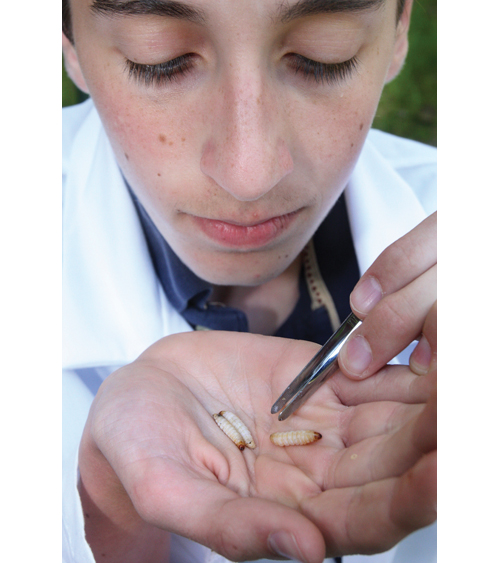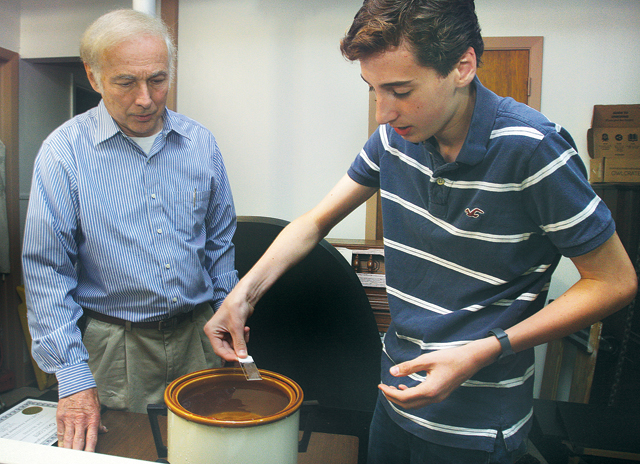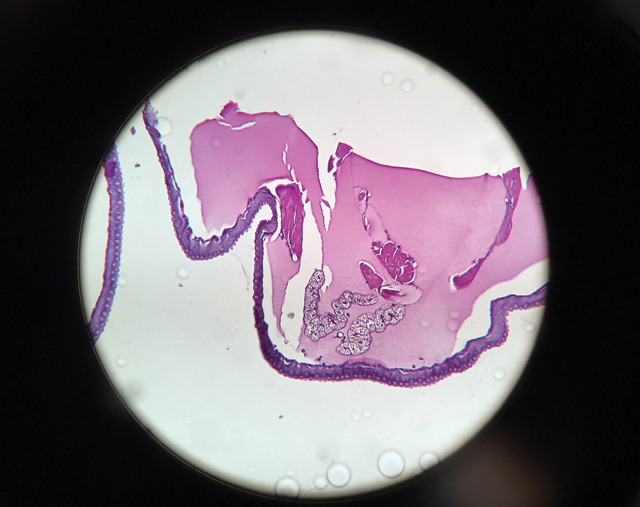Greenport teen aiming to solve global honeybee problem


Joe McInnis was fully prepared last Wednesday when the time came for his presentation to students in a science research class at Southold High School.
After all, the Greenport eighth-grader had already given a similar presentation on his work with honeybees to a group of adults at the New York State Histotechnological Society in Albany.
If you’re wondering exactly what a 14-year-old knows about bees, consider that Joe has spent the past year working with retired Plum Island veterinary pathologist Doug Gregg to find an explanation for colony collapse disorder, which has affected honeybee populations worldwide.
Joe’s work has made him the youngest person ever to receive the Gulf Coast Instrument Award, a $250 scholarship to help fund his research.
CCD has been present since 2006 and presents itself specifically as a dead colony, one containing no adult bees and no dead bee bodies. The colony does, however, contain a live queen as well as honey, and immature bees are usually still present, according to the U.S. Department of Agriculture.
Working together out of Dr. Gregg’s piano repair studio in Greenport, the research partners learned that an immune depletion virus transmitted from worms to mites and then to honeybees could be the cause of CCD.
Joe said the virus he’s investigating doesn’t kill the bees. Rather, it weakens the immune system so that when a honeybee contracts a less serious disease, such as nosema, that disease becomes fatal. Nosema is a “common gut parasite in honeybees,” Dr. Gregg said.
“It’s tough to solve,” he said, adding that Joe is doing scientific work equivalent to that of Ph.D. students. “But if he solves it, it will be earth-shaking.”
The research process began two years ago when retired Riverhead High School biology teacher Bob Jester, who is also a chimney sweep, was doing work at the McInnis home. Joe, a sixth-grader at the time, spoke with Mr. Jester about his interest in biology and the former teacher began tutoring him at a 10th-grade level after school.
Once Joe completed the coursework, Mr. Jester suggested he work on a research project and began reaching out to local scientists to help.
While working at Plum Island, Dr. Gregg had treated African swine flu — a virus similar to CCD. He had also recently read an article about CCD published by the U.S. Army and was eager to help Joe in his research. He began collecting donated equipment and started working with the teen about a year ago.
“I’ve never been so excited about a project a young person has developed,” Mr. Jester said.
Joe said he spent the first few months talking through ideas with Dr. Gregg before learning how to use the equipment.
In order to determine if his theory explains the cause of CCD, Joe injects the immunodepressant virus into a group of worms he keeps in the attic of his family’s home, where he monitors them daily, waiting to see if parts of their bodies turn a bluish color.
If they do, Joe then injects the worms with virus antibodies he created by injecting a rabbit with the virus. Joe assured that the virus has no affect on the mammal. These antibodies allow him to observe the travel of the virus throughout the worms, he said.

The worms are then submerged in three different alcohol-based chemical mixtures that remove the water from the organisms. He then molds the worms into wax squares and uses a microtome to create pieces about 1/16 the thickness of a strand of hair. The strips are then dyed and placed on microscopic slides to be examined.
“This is our seventh group of [worms],” Joe said. “We haven’t gotten the virus to work yet, but I think a couple of these are blue, so I think it worked this time … which is really exciting.”
Once the worm phase of their research is complete, the duo’s goal is to replicate this process with mites and later with bees.
Dr. Gregg said this type of worm, called a wax worm, is often found living in honeybee colonies and was discovered to have a parasitic relationship with the mites that also co-inhabit the hives. Similarly, those mites have a parasitic relationship with honeybees, which is how the science team believes the virus gets transferred.
“I think this is very promising,” Dr. Gregg said.
Joe added that finding a cure for CCD is of the utmost importance because about one-third of the world’s food supply depends on honeybee pollination.
“Albert Einstein once said, ‘If the bee disappeared off the face of the Earth, man would only have four years left to live,’ ” Joe said during his presentation last week.
Joe said the research is especially relevant to the North Fork because the local economy is heavily dependent on grapes, which are pollinated by bees.
Joe hopes to study microbiology in college and wants to continue doing research projects once his current investigation is completed. Dr. Gregg said it’s difficult to predict how long research can take, but at the current rate they expect to work for another two or three years on CCD.
Joe’s main goal, however, is to get his discovery published in a scientific journal.
He also has more local presentations to give, including one at Peconic Landing at 8 p.m. Tuesday, June 14, and another at the East End Seaport Museum at 7 p.m. Thursday, June 23. Both events are free and open to the public.

Top photo: Joe McInnis, a Greenport eighth-grader, examines the wax worms he injected with an immune-despressing virus. (Credit: Barbaraellen Koch)








